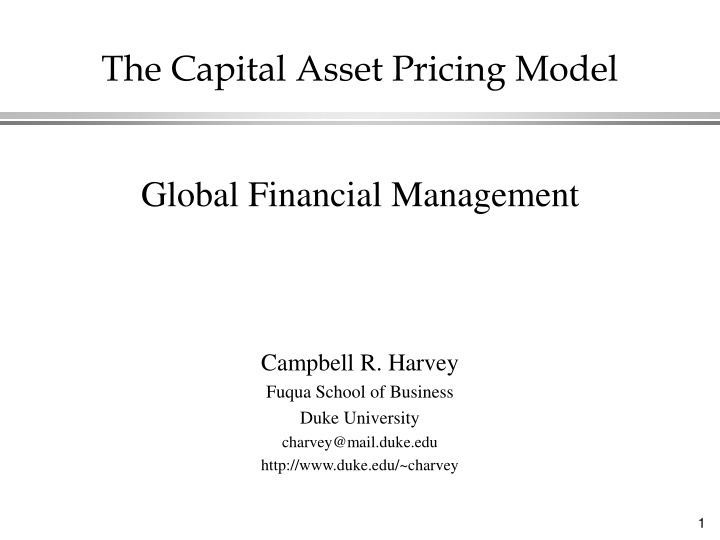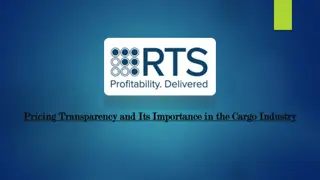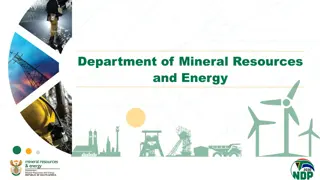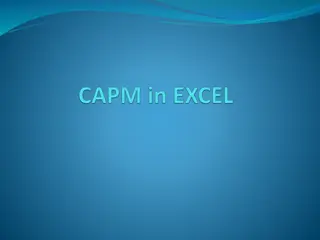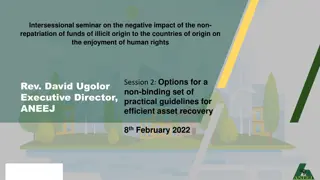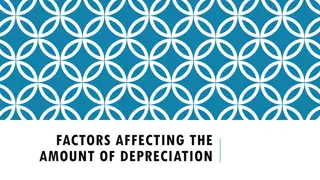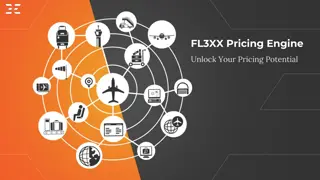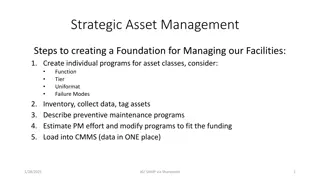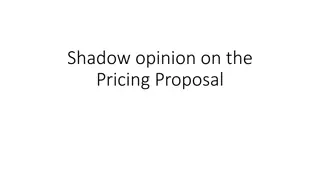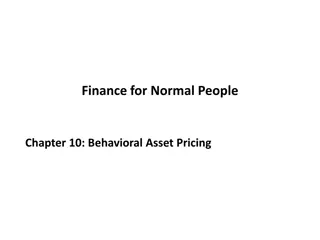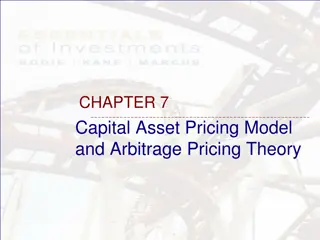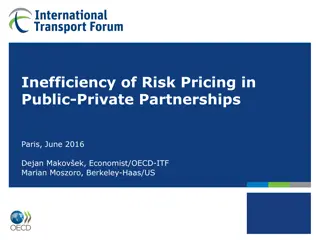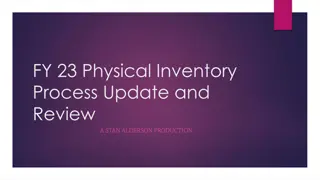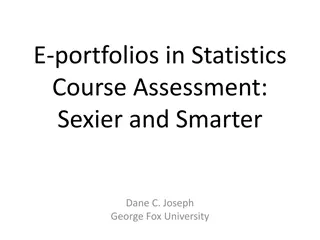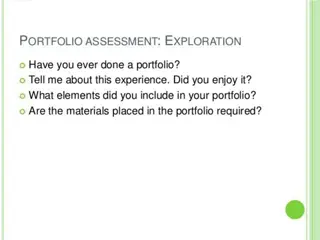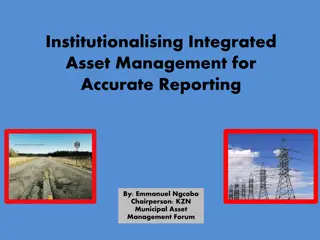Capital Asset Pricing Model & Efficient Portfolios
This content covers topics like the Capital Asset Pricing Model, efficient portfolio selection, risk-free assets, utility in risk-return space, individual asset allocations, and the impact of introducing a risk-free asset on investment choices. It explores concepts such as expected return, variance, risk-return tradeoff, and asset allocation strategies.
Download Presentation

Please find below an Image/Link to download the presentation.
The content on the website is provided AS IS for your information and personal use only. It may not be sold, licensed, or shared on other websites without obtaining consent from the author.If you encounter any issues during the download, it is possible that the publisher has removed the file from their server.
You are allowed to download the files provided on this website for personal or commercial use, subject to the condition that they are used lawfully. All files are the property of their respective owners.
The content on the website is provided AS IS for your information and personal use only. It may not be sold, licensed, or shared on other websites without obtaining consent from the author.
E N D
Presentation Transcript
The Capital Asset Pricing Model Global Financial Management Campbell R. Harvey Fuqua School of Business Duke University charvey@mail.duke.edu http://www.duke.edu/~charvey 1
Overview Utility and risk aversion Choosing efficient portfolios Investing with a risk-free asset Borrowing and lending The markt portfolio The Capital Market Line (CML) The Capital Asset Pricing Model (CAPM) The Security Market Line (SML) Beta Project analysis 2
Efficient Portfolios with Multiple Assets Efficient Frontier Investors prefer E[r] Portfolios of other assets Asset 1 Portfolios of Asset 1 and Asset 2 Asset 2 Minimum-Variance Portfolio 0 3
Utility in Risk-Return Space Indifference curves 25.00% tau=0.5, Ubar=6% Investors prefer tau=0.5, Ubar=8% tau=0.5, Ubar=10% 20.00% tau=0.25, Ubar=6% tau=0.25, Ubar=8% 15.00% Return tau=0.5, Ubar=10% 10.00% 5.00% 0.00% Risk 4
Individual Asset Allocations Point x is the optimal portfolio for the less risk averse investor (red line) Point y is the optimal portfolio for the more risk averse investor (black line) 16.00% Return 14.00% 12.00% x y 10.00% 8.00% 6.00% 4.00% 2.00% Risk 0.00% 5.00% 6.00% 7.00% 8.00% 9.00% 14.00% 10.00% 11.00% 12.00% 13.00% 15.00% 16.00% 17.00% 18.00% 19.00% 20.00% 5
Introducing a Riskfree Asset Suppose we introduce the opportunity to invest in a riskfree asset. How does this alter investors portfolio choices? The riskfree asset has a zero variance, and zero covariance with every other asset (or portfolio). var(rf) = 0. cov(rf, rj) = 0 for all j. What is the expected return and variance of a portfolio consisting of a fraction (1- )of the riskfree asset and of the risky asset (or portfolio)? 6
Risk and Return with a Riskfree asset Expected Return E r E r P = ( ) + 1 r j f Variance and Standard Deviation 2 2 2 = = = Var rP P j P j Hence, the risk-return tradeoff is: ( E r r E r P f j ) P = + r j j 7
Risk and Return with a Riskfree asset Expected Return The line represents all portfolios depending on Asset j ( =1) E(rj) rf Riskfree asset ( =0) j 0 Standard Deviation 8
Investing with Borrowing and Lending Expected Return a = 2 a = 05 . M E rM [ ] a =1 rf a=0 Lending Borrowing 0 sM Standard Deviation 9
Optimal Investing With Borrowing and Lending 25.00% Y = optimal risk- return tradeoff for risk-averse investor X = optimal risk- return tradeoff for risk-tolerant investor Return tau=0.5, Ubar=8% 20.00% tau=0.25, Ubar=6% Portfolio 15.00% 10.00% X 5.00% Y Risk 0.00% rf=4% 1 3 5 7 9 11 13 15 17 19 21 23 25 27 10
The Capital Market Line Expected Return M E rm [ E rIBM [ ] ] A IBM rf Standard Deviation Systematic Risk Diversifiable Risk 11
The Capital Market Line The CML gives the tradeoff between risk and return for portfolios consisting of the riskfree asset and the tangency portfolio M. Portfolio M is the market portfolio. The equation of the CML is: E r ( ) r M f = + E r ( ) r p f p M The expected rate of return on a risky asset can be thought of as composed of two terms. The return on a riskfree security, like U.S. Treasury bills; compensating investors for the time value of money. A risk premium to compensate investors for bearing risk. E(r) = rf + Risk x [Market Price of Risk] 12
Everybody holds the Market Everybody holds the tangency portfolio M If all hold the same portfolio, it must be the market! Nobody can do better than holding the market If another asset existed which offers a better return for the same risk, buy that! Can t be an equilibrium Write the weight of asset j in the market portfolio as wj. Then we have: ( ) ( ) ( ) Var r w w Cov r r M i j j i = = 1 1 ( ) = j N = = + E r w E r j r r M j f f 1 j ( ) i N = j N = = , j i Simply use expressions for multi-asset case 13
All Risk-Return Tradeoffs are Equal Hence, if you increase the weight of asset j in your portfolio (relative to the market), Then expected returns increase by: ( ) E r r j f Then the riskiness of the portfolio increases by: ( wCov r r Cov r r i j i i , = 1 ( ) ) N = , j M Hence, the return/risk gain is: ( ) ( Cov r r j M , E r r j f ) This must be the same for all assets Why? 14
All Assets are Equal Suppose that for two assets A and B: ( ) ( ( ) ( , , E r Cov r r r E r Cov r r r A f B f ) ) A M B M Asset A offers a better return/risk ratio than asset B Buy A, sell B What if everybody does this? Hence, in equilibrium, all return/risk ratios must be equal for all assets ( ) ( ) ( ) Cov r r Cov r r A M B M , , ( ) E r E r r r A f B f = 15
The Capital Asset Pricing Model If the risk-return tradeoff is the same for all assets, than it is the one of the market: ( ) ( ) ( ) Cov r r Cov r r Var r A M B M , , ( ) E r ( ) E r r r E r r A f B f M f = = ( ) M This gives the relationship between risk and expected return for individual stocks and portfolios. This is called the Security Market Line. ( ) ( ) Var r M , Cov r r ( ( ) ) ( ) E r ( ( ) ) A M = + = + r E r r r E r r A f M f f A M f ( ) , Cov r r Var r A M A = where ( ) M 16
Capital Asset Pricing Model A Graphical Illustration Expected Return Expected Market Return Expected market risk premium Risk free rate 0 0.5 1.0 Beta factor Beta Expected return Risk free rate Expected market risk premium = + x 17
The Intuitive Argument For the CAPM Everybody holds the same portfolio, hence the market. Portfolio-risk cannot be diversified. Investors demand a premium on non-diversifiable risk only, hence portfolio or market risk. Beta measures the market risk, hence it is the correct measure for non-diversifiable risk. Conclusion: In a market where investors can diversify by holding many assets in their portfolio, they demand a risk premium proportional to beta. 18
The SML and mispriced stocks Suppose for a particular stock: ( ) , Cov r r ( ) E r ( ) j M + r E r r ( ) j M f f Var r M Remember the definition of expected returns: ( ) 1 1 0 + E P D P ( ) E r j j j = j 0 P j Then P0 falls, so that E(rj) increases until disequilibrium vanishes and the equation holds! 19
The SML and mispriced stocks Expected Return Stock j is overvalued at X: price drops, expected return rises. At Y, stock j would be undervalued! expected return falls price increases E(rM) Y X rf =1 j 20
The CML and SML E(r) CML E(r) SML M M E(rM) E(rIBM) IBM rf rf IBM,M/ M M IBM IBM 1.0 21
The Capital Asset Pricing Model The appropriate measure of risk for an individual stock is its beta. Beta measures the stock s sensitivity to market risk factors. The higher the beta, the more sensitive the stock is to market movements. The average stock has a beta of 1.0. Portfolio betas are weighted averages of the betas for the individual stocks in the portfolio. The market price of risk is [E(rM)-rf]. 22
Using Regression Analysis to Measure Betas Rate of Return on Stock A Slope = Beta x x x x x x x x x x Rate of Return on the Market x x x x x Jan 1995 23
Calculating the beta of BA Return on BA 40 30 20 10 0 -10 -20 Beta -30 -40 -30 -20 -10 0 10 20 Beta is the slope of a regression line which best fits the scatter of monthly returns on the share and on the market index. Return on the market index 24
Betas of Selected Common Stocks Stock Beta Stock Beta AT&T Boston Ed. BM Squibb Delta Airlines Digital Equip. Dow Chem. Exxon Merck 0.96 0.49 0.92 1.31 1.23 1.05 0.46 1.11 Ford Motor Home Depot McDonalds Microsoft Nynex Polaroid Tandem UAL 1.03 1.34 1.06 1.20 0.77 0.96 1.73 1.84 Betas based on 5 years of monthly returns through mid-1993. 25
Beta and Standard Deviation Risk of a Share (Variance) Market risk of the share Specific risk of the share = + Beta of share Risk of market This is the major element of a share's risk x Risk of a portfolio Market risk of the portfolio Specific risk of the portfolio = + Beta of Portfolio Risk of market This is negligible for a diversified portfolio x 26
Testing the CAPM Black, Jensen and Scholes Average Monthly Return Theoretical Line Fitted Line Beta 27
Estimating the Expected Rate of Return on Equity The SML gives us a way to estimate the expected (or required) rate of return on equity. ( ) E r r E r r j f j M f = + ( ) We need estimates of three things: Riskfree interest rate, rf. Market price of risk, [E(rM)-rf]. Beta for the stock, j. 28
Estimating the Expected Rate of Return on Equity The riskfree rate can be estimated by the current yield on one-year Treasury bills. As of early 1997, one-year Treasury bills were yielding about 5.0%. The market price of risk can be estimated by looking at the historical difference between the return on stocks and the return on Treasury bills. This difference has averaged about 8.6% since 1926. The betas are estimated by regression analysis. 29
Estimating the Expected Rate of Return on Equity E(r) = 5.0% + (8.6%) Stock E(r) 13.3% Ford Motor 9.2% Home Depot 12.9% McDonalds 16.3% Microsoft 15.6% Nynex 14.0% Polaroid 9.0% Tandem 14.5% UAL Stock E(r) 13.9% 16.5% 14.1% 15.3% 11.6% 13.3% 19.9% 20.8% AT&T Boston Ed. BM Squibb Delta Airlines Digital Equip. Dow Chem. Exxon Merck 30
Example of Portfolio Betas and Expected Returns What is the beta and expected rate of return of an equally-weighted portfolio consisting of Exxon and Polaroid? Portfolio Beta = = + ( / )(. . 071 1 2 46 ) ( / )(. 1 2 96 ) p p Expected Rate of Return = 50% + = E rp ( ) . ( . 86%)(071 . ) 111% . How would you construct a portfolio with the same beta and expected return, but with the lowest possible standard deviation? Use the figure on the following page to locate the equally-weighted portfolio of Exxon and Polaroid. Also locate the minimum variance portfolio with the same expected return. 31
Graphical Illustration E(r) E(r) SML CML M M 13.6% 11.1% 5.0% 5.0% M 0.71 1.0 32
Example The S&P500 Index has a standard deviation of about 12% per year. Gold mining stocks have a standard deviation of about 24% per year and a correlation with the S&P500 of about = 0.15. If the yield on U.S. Treasury bills is 6% and the market risk premium is [E(rM)-rf] = 7.0%, what is the expected rate of return on gold mining stocks? 33
Example The beta for gold mining stocks is calculated as follows: M M 12 . gM 2 15 24 . (. ) gM 2 g M = = = = 0 30 . The expected rate of return on gold mining stocks is: = + = E rg ( ) 6 0% . ( . 7 0%)(0 30 . ) 71% . Question: What portfolio has the same expected return as gold mining stocks, but the lowest possible standard deviation? Answer: A portfolio consisting of 70% invested in U.S. Treasury bills and 30% invested in the S&P500 Index. Beta E r Sd r p = + = ( ) (. )( ) (. )( . . 7 0 3 12 0%) 36% = + + = . (. )( ) . 60% 7 0 (. )( . ) ( . 7 0%)(030 3 10 030 . ) = = ( ) 81% . p 34
Using the CAPM for Project Evaluation Suppose Microsoft is considering an expansion of its current operations. The expansion will cost $100 million today expected to generate a net cash flow of $25 million per year for the next 20 years. What is the appropriate risk-adjusted discount rate for the expansion project? What is the NPV of Microsoft s investment project? 35
Microsofts Expansion Project The risk-adjusted discount rate for the project, rp, can be estimated by using Microsoft s beta and the CAPM. ( ) E r = + r r r P m f f Thus, the NPV of the project is: ( ) rP= + 0 05 12 . . * 0 086 . $25 . 1153 20 = = $100 $53. 92 NPV million ( ) t = 1 t 36
Company Risk Versus Project Risk The company-wide discount rate is the appropriate discount rate for evaluating investment projects that have the same risk as the firm as a whole. For investment projects that have differentrisk from the firm s existing assets, the company-wide discount rate is not the appropriate discount rate. In these cases, we must rely on industry betas for estimates of project risk. 37
Company Risk versus Project Risk Suppose Microsoft is considering investing in the development of a new airline. What is the risk of this investment? What is the appropriate risk-adjusted discount rate for evaluating the project? Suppose the project offers a 17% rate of return. Is the investment a good one for Microsoft? 38
Industry Asset Betas Industry Beta 1.80 1.60 1.45 1.30 1.25 1.20 1.05 1.05 1.00 Industry Beta 1.00 1.00 0.90 0.85 0.85 0.80 0.75 0.60 0.35 Airlines Electronics Consumer Durables Producer Goods Chemicals Shipping Steel Containers Nonferrous Metals Source: D. Mullins, Does the Capital Asset Pricing Model Work?, Havard Business Review, vol. 60, pp. 105-114. Agriculture Food Liquor Banks International Oils Tobacco Telephone Utilities Energy Utilities Gold 39
Company Risk versus Project Risk The project risk is closer to the risk of other airlines than it is to the risk of Microsoft s software business. The appropriate risk-adjusted discount rate for the project depends upon the risk of the project. If the average asset beta for airlines is 1.8, then the project s cost of capital is: ( r r E r r p f p m f = + ) ( ) rp= + = 005 18 0086 . . . 205% . 40
Company Risk versus Project Risk Required Return SML Project-specific Discount Rate Project IRR A Company-wide Discount Rate Company Beta Project Beta 41
Project Evaluation: Rules The risk of an investment project is given by the project s beta. Can be different from company s beta Can often use industry as approximation The Security Market Line provides an estimate of an appropriate discount rate for the project based upon the project s beta. Same company may use different discount rates for different projects This discount rate is used when computing the project s net present value. 42
Summary Optimal investments depend on trading off risk and return Investors with higher risk tolerance invest more in risky assets Only risk that can t be diversified counts If investors can borrow and lend, then everybody holds a combination of two portfolios The market portfolio of all risky assets The riskless asset Covariance with the market portfolio counts In equilibrium, all stocks must lie on the security market line Beta measures the amount of nondiversifiable risk Expected returns reflect only market risk Use these as required returns in project evaluation 43
